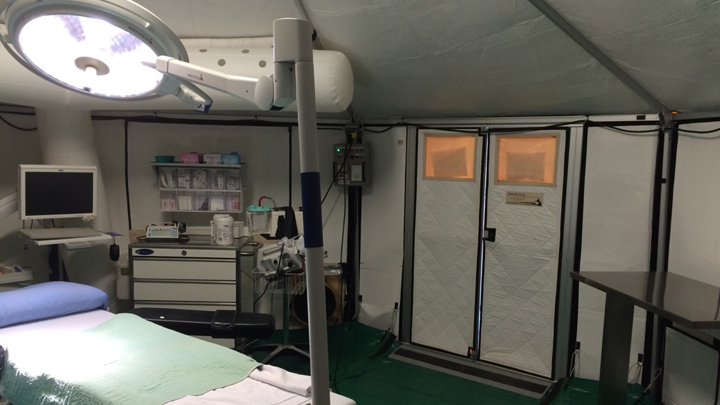
June 3, 2016

Operating Room setup in the state-of-the-art Portable Isolation Containment System (PICS) units being used as a temporary Urgent Care Centre at the Syncrude Sport and Wellness Centre in Fort McMurray.
Story by Sara Warr
FORT MCMURRAY - It sounds like a scene from the 1980’s sitcom M.A.S.H. – a tent set up in a parking lot with an operating room (OR) inside. But with state of the art air handling units and stringent infection prevention protocols matching those of a formal hospital surgical suite, the temporary OR at the Fort McMurray Urgent Care Centre (UCC) was more like NASA’s International Space Station.
While it was never used, the OR was necessary in case a rare emergency situation presented itself, where life or limb was at imminent risk and transferring the patient was deemed too risky.
“It wasn’t a makeshift operation by any stretch of the imagination,” says Karen Espersen, Alberta Health Services (AHS) surgical services manager at the Northern Lights Regional Health Centre (NLRHC) in Fort McMurray. “It was pretty impressive. Physicians and staff from all areas were very diligent in ensuring everything complied with the standards that you need to run an operating room.”
The tents, or Portable Isolation Containment System (PICS), were initially designed and developed for isolation and treatment of viral and biological contamination, as well as communicable diseases. The isolation and containment system – which has the ability to be set up in either positive or negative pressure - is robust enough to be used in such emergent health care challenges as SARS and Ebola.
The PICS meets relevant Infection Prevention and Control standards, Environmental Public Health standards. This includes maintaining positive air pressure and temperature, ensuring air quality and potable water in the OR and proper handling of equipment, linens, instruments and biohazardous material disposal.
“We’re a little more sophisticated than M.A.S.H. now, thank goodness,” says Debra Doe, AHS director for infection prevention and control. “Our role was to ensure that there’s proper air flow and air exchanges in the OR to prevent surgical site infections, to look at work flow and access to hand hygiene and make sure that as equipment was brought in and the tent was assembled, that it could be cleaned appropriately. Ensuring patient safety is everyone’s primary consideration.”
Physicians and clinical staff, emergency medical services (EMS), environmental services, contracting, procurement and supply management (CPSM) and other departments all played a part in ensuring emergency surgical services were available in the community once again.
“With the surgeons, we reviewed the types of surgeries that we’d be able to provide,” explains Espersen. “Emergency ceasarian section or ruptured ectopic pregnancies, control of hemorrhagic shock, emergency laporatomies or tracheotomies - those types of procedures. We had to make it happen, and we did.”
Some of the AHS staff who contributed came from elsewhere in the province, including Doe who calls Red Deer home. But for those from Fort McMurray, helping to get their community back on its feet has been part of the healing process.
“It’s been a pretty solid couple of weeks, for sure, but I’m happy to be back,” says Espersen, who evacuated with the rest of the NLRHC to Suncor’s Firebag site on May 3rd. “Being back at work has been very therapeutic. It’s not just the strength of one, it’s the strength of many because we’re not on this journey alone, we’re in this as a team.”